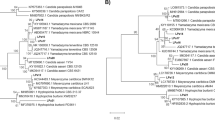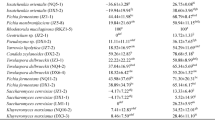Abstract
Mango is an economically important fruit crop in Brazil and attacked by fungal diseases that require control. Currently, ensuring that fruit are free of pesticide residues before consumption is a key challenge in postharvest pathology. The fungus Botryosphaeria dothidea is the major pathogen and there is currently no efficient method for its control. This work aimed to evaluate the efficacy of yeast strains and the mechanisms involved in the biocontrol of mango rot caused by B. dothidea. The ability of seven yeast strains to control mango rot was compared to thiabendazole fungicide (485 g ai 100 L−1). The modes of action involved in biocontrol were investigated by electron microscopy observations, as well bioassays for the production of inhibitory volatile compounds, chitinases, killer toxins and competition for nutrients and yeast colony layer interference. Strains of Candida membranifaciens and Meyerozyma guilliermondii reduced the severity of mango rot during 11-day storage period. Among them, C. membranifaciens (CMAA 1108) showed highest efficacy when compared to fungicide-treated fruit. No strains produced inhibitory substances against B. dothidea. Electron microscopy revealed an effective colonization by yeasts in the wounds. It is suggested that competition, as well as the establishment of a yeast colony layer after colonization, plays an important role in the reduction of mango fruit rot severity.


Similar content being viewed by others
References
Al-Fattani MA, Douglas LJ (2004) Penetration on Candida biofilms by antifungal agents. Antimicrobial Agents and Chemotherapy 48:3291–3297
Anuário Brasileiro da Fruticultura 2016. (2016) Santa Cruz, RS: Gazeta Santa Cruz
Arras G, Scherm B, Migheli Q (2002) Improving biocontrol activity of Pichia guillermondii against post-harvest decay of orange in commercial packing-houses by reduced concentrations of fungicides. Biocontrol Science and Technology 12:547–553
Benchimol M, Attias M, Silva NLC, Carvalho TMU (1996) Métodos de estudo da célula. Fundação Estadual Norte Fluminense, Rio de Janeiro, RJ
Campbell CL, Madden LV (1990) Introduction to plant disease epidemiology. USA. John Wiley and Sons, New York
Chanchaichaovivat A, Panijpan B, Ruenwongsa P (2008) Putative modes of action of Pichia guilliermondii strain R13 in controlling chilli anthracnose after harvest. Biological Control 47:207–215
Costa VSO, Michereff SJ, Martins RB, Gava CAT, Mizubuti ESG, Camara MPS (2010) Species of Botryosphaeriaceae associated on mango in Brazil. European Journal of Plant Pathology 127:509–519
Cruz MJS, Clemente E, Cruz MES, Mora F, Cossaro L, Pelisson N (2010) Efeito dos compostos naturais bioativos na conservação pós-colheita de frutos de mangueira. Ciência e Agrotecnologia 34:428–433
Davit Y, Byrne H, Osborne J, Pitt-Francis J, Gavaghan D (2013) Hydrodynamic dispersion within porous biofilms. Physical Review E 87:1–16
Food and Agriculture Organization of the United Nations (2009) The market for organic and fair-trade mangoes. FAO, Rome, Italy
Janisiewicz WJ, Pimenta RS, Jurick WM (2011) A novel method for selecting antagonists against postharvest fruit decays originating from latent infections. Biological Control 59:384–389
Kefialew Y, Ayalew A (2008) Postharvest biological control of anthracnose (Colletotrichum gloeosporioides) on mango (Mangifera indica). Postharvest Biology and Technology 50:8–11
Lahlali R, Massart S, De Clercq D, Serrhini MN, Creemers P, Jijakli MH (2009) Assessment of Pichia anomala (strain K) efficacy against blue mould of apples when applied pre- or post-harvest under laboratory conditions and in orchard trials. European Journal of Plant Pathology 123:37–45
Lins SRO, Oliveira SMA, Alexandre ER, Santos AMG, Oliveira TAS (2011) Controle alternativo de podridão peduncular em manga. Summa Phytopathologica 37:121–126
Liu J, Sui L, Wisniewski M, Droby S, Liu Y (2013) Utilization of antagonistic yeasts to manage postharvest fungal diseases of fruit. International Journal of Food Microbiology 167:153–160
Marín S, Ramos AJ, Sanchis V (2005) Comparison of methods for the assessment of growth of food spoilage moulds in solid substrates. International Journal of Food Microbiology 99:329–341
Nascimento FV, Santos MC, Valdebenito-Sanhueza RM, Bartnicki VA (2014) Hidrotermia e radiação UV-C no controle de patógenos de manga e melão. Summa Phytopathologica 40:313–317
Pu L, Jingfan F, Kai C, Chao-an L, Yunjiang C (2014) Phenylethanol promotes adhesion and biofilm formation of the antagonistic yeast Kloeckera apiculata for the control of blue mold on citrus. FEMS Yeast Research 14:536–546
Ren X, Kong Q, Wang H, Yu T, Zhou W, Zheng X (2012) Biocontrol of fungal decay of citrus fruit by Pichia pastoris recombinant strains expressing cecropin A. Food Chemistry 131:796–801
Renwick A, Campbell R, Coe S (1991) Assessment of in vitro screening systems for potential biocontrol agents of Gaeumannomyces graminis. Plant Pathology 40:524–532
Ruan J, Li M, Jin H, Sun L, Zhu Y, Xu M, Dong J (2015) UV-B irradiation alleviates the deterioration of cold-stored mangoes by enhancing endogenous nitric oxide levels. Food Chemistry 169:417–423
Santos A, Marquina D (2004) Killer toxin of Pichia membranifaciens and its possible use as a biocontrol agent against grey mould disease of grapevine. Microbiology 150:2527–2534
Spadaro D, Ciavorella A, Zhang D, Garibaldi A, Gullino ML (2010) Effect of culture media and pH on the biomass production and biocontrol efficacy of a Metschnikowia pulcherrima strain to be used as a biofungicide for postharvest disease control. Canadian Journal of Microbiology 56:128–137
Sharma RR, Singh D, Singh R (2009) Biological control of postharvest diseases of fruits and vegetables by microbial antagonists: a review. Biological Control 50:205–221
Spadaro D, Droby S (2016) Development of biocontrol products for postharvest diseases of fruit: The importance of elucidating the mechanisms of action of yeast antagonists. Trends in Food Science and Technology 47:39–49
Terao D, Campos JSC, Benato EA, Hashimoto JM (2015) Alternative strategy on postharvest diseases of mango (Mangifera indica L.) control by use of low dose of ultraviolet-C irradiation. Food Engineering Reviews 7:171–175
Woods DR, Bevan EA (1968) Studies on the nature of the killer factor produced by Saccharomyces cerevisiae. Journal of General Microbiology 51:115–126
Zhang D, Spadaro D, Garibaldi A, Gullino ML (2011) Potential biocontrol activity of Pichia guilliermondii strain against grey mould of apples and its possible modes of action. Biological Control 57:193–201
Zhang H, Wang L, Ma L, Dong Y, Jiang S, Xu B, Zheng X (2009) Biocontrol of major postharvest pathogen on apple using Rodothorula glutinis and its effects on postharvest quality parameters. Biological Control 48:79–83
Zhang H, Wang L, Dong Y, Jiang S, Cao J, Meng R (2007) Postharvest biological control of gray mold decay of strawberry with Rhodotorula glutinis. Biological Control 40:287–292
Zhao Y, Tu K, Shao XF, Jing W, Su ZP (2008) Effects of yeast Pichia guilliermondii against Rhizopus nigricans on tomato fruit. Postharvest Biology and Technology 49:113–120
Acknowledgements
This research was supported by Fundação de Amparo à Pesquisa do Estado de São Paulo-FAPESP (Projeto FAPESP 2011/23432-8). The authors thank Research Support Centre in Electron Microscopy applied to Agricultural Research (ESALQ/USP) for the use of scanning electron microscopy equipment and Rosely dos Santos Nascimento from Embrapa Meio Ambiente for the support.
Author information
Authors and Affiliations
Corresponding author
Additional information
Section Editor: Jorge T. de Souza
Rights and permissions
About this article
Cite this article
Terao, D., de Lima Nechet, K. & de Almeida Halfeld-Vieira, B. Competitive and colony layer formation ability as key mechanisms by yeasts for the control Botryosphaeria dothidea fruit rot of mango. Trop. plant pathol. 42, 451–457 (2017). https://doi.org/10.1007/s40858-017-0183-z
Received:
Accepted:
Published:
Issue Date:
DOI: https://doi.org/10.1007/s40858-017-0183-z




